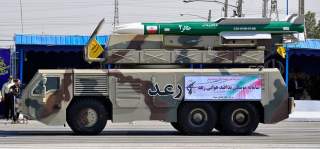Iran: A Bigger and Badder Threat than ISIS?
"Now, the issues of both ISIL and Iran must be confronted and resolved closer together."
Once alerted to the menace posed by brutal terrorists in Iraq and Syria, the world has swung into action with vigor and resolve—and enough potent military hardware to make even the most hardened terrorist think twice. Already ISIL’s decentralizing its main force elements to hide amidst innocent women and children. Truly, atrocity and cowardice are bedfellows.
But focusing excessively on ungoverned spaces in Iraq and Syria can distract from broader strategic priorities. Highlighting one dilemma can diminish our international peripheral vision, to the point where other pressing issues seem to have abated or disappeared.
Part of the challenge with ISIL is to degrade and contain it, while not constraining the international community’s broader focus. Admittedly, ISIL casts a long and fearful shadow, but there are potentially worse—albeit quieter—threats lurking, which also demand urgent attention.
They include the maverick trifecta of Iran, Russia and North Korea. Unlike ISIL, each of those international “problem-states” comes disproportionately better armed, including a ready-made or emerging nuclear capability, accompanied by an unpredictable senior leadership.
The first unresolved problem confronting the world is what exactly to do about Iran. The threat of a nuclear-armed Iran would dwarf that which is posed by ISIL, whose mayhem and carnage a coalition of nations is now working to suppress. For almost a decade, since September 2006, Iran has steadfastly and with contempt thumbed its nose at the international community, by remaining deliberately in breach of its nuclear arms control obligations.
It has taken that sustained and obdurate stance for three reasons. First, because of the prestige, power and authority which Iran believes such weapons would give it, both regionally and beyond. In some Iranian eyes it would be a much stronger player to be feared by all parties; even an equal to Israel. Second, Iran’s strategic leadership remains fundamentally and violently opposed to a world order in which both the United States and Israel continue to retain disproportionate influence. And, third, Iran probably interprets longstanding international inaction on their nuclear weapons program to date as a strong indicator of longer-term vacillation and weakness.
The issues of ISIL and Iran overlap in at least two ways. The international community’s focus on the former gives Iran more time and enhanced cover to develop its thinly veiled nuclear capability. And depending on how current to mid-term events unfold in the Middle East, Tehran might see a pretext, or reason, to initiate military action against ISIL in its own right, at least to further extend or expand proxy-military actions against the West.
Doubtless, those sensitivities and threats are well appreciated by the war’s principal leaders; including ISIS/ISIL’s own twisted hierarchy. But what’s perhaps less acknowledged, at least publicly, is the growing need now for ISIL to be degraded and contained, concurrent with a broad and holistic internationally agreed approach to Iran.
By having put Iran on the backburner for the last decade—for obvious and understandable reasons called Iraq and Afghanistan—the world, and especially the West, has forfeited the opportunity of solving the problems separately.
Now, the issues of both ISIL and Iran must be confronted and resolved closer together. At the least, it’s time for the international community to engage and agree upon an effective strategy to contain Iran.
Almost certainly, such a strategy will include multiple and complementary lines of engagement across the international community and with Iran itself. Those will embrace the broad sweep from diplomacy, to international consensus and coalition building, to economic sanctions, and in extremis, the possibility of military action.
By default, the US, as it has done with ISIL, must inevitably lead the way, notwithstanding its inherent national war-weariness. But whichever combination of the above is agreed, the time for action on Iran is now much closer than it has ever been.
The wider world was finally roused to the true menace of ISIL by its evil mix of malevolent atrocity exported by social media. But replace the ghastly specter of ISIL’s severed heads and slain thousands, with an Iranian nuclear device used somewhere in the Middle East—and the mind is concentrated wonderfully, about the broader potential for a worse crisis.
It’s time the international community took Iran off the backburner.
This piece first appeared in ASPI's The Strategist here.
Image: Creative Commons.

